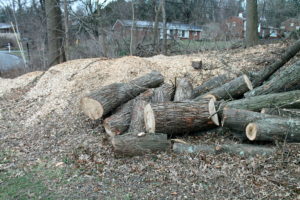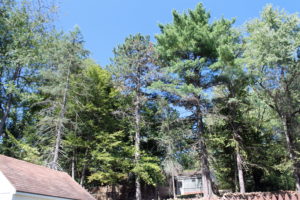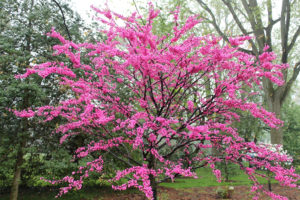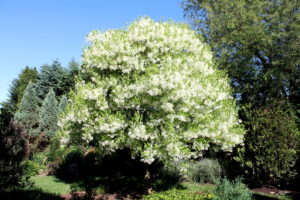More Trees, Please
April 21st, 2020
I’m running a deficit right now. Money and energy, too, but the one I’m talking about has to do with trees.
When my wife, Sue, and I moved to Pittsburgh last year, we inherited a long-unkempt lot that had a variety of dead, dying, and hazard trees.
A huge, struggling pin oak was easily within striking range of the house, and an even bigger silver maple had grown a branch the size of a municipal sewer line over our shed.
A 40-foot-tall Colorado blue spruce dying from needlecast disease was our front-yard “specimen,” and six smaller to mid-sized blue spruces were already totally needle-less on the side and back banks.
I cut down the smaller ones and hired a tree company to handle the big ones, forking out $7,000 in the process.
I hate to be a tree-killer, but sometimes the deed has to be done. Trees are nice in the landscape for lots of reasons, but they’re not so good on top of our power lines or through our attics.
Dead trees are going to eventually fall, and when there’s a target in range, it’s better that we get them down ASAP in a controlled way.
Besides flat-out failing old trees, we’re losing lots of Douglas firs and Colorado blue spruces lately to needlecast, and emerald ash borers have been wiping out virtually our whole covering of ash trees.
Many communities – ours included – have been reporting alarming losses of tree canopies when compared to just a decade or two ago. (The Pa. Department of Conservation and Natural Resources has an interactive Community Tree Map if you want to see tree-coverage data from around the state.)
The way I look at it, tree-removal can be a good thing in the long run if we’re all replacing older, failing, inferior, and/or hazard trees with newer ones that are better suited to the sites.
That’s what I’m working on now. And April is an ideal time to plant.
Read George’s article on “So You Think You Know How to Plant a Tree?”
My goal is to not only replace all of the cut-down trees but to end up with twice as many – and with a much more diverse selection than this little half-acre had before.
A half of an acre is bigger than a lot of lots, which means I could get away with some bigger species than small yards, which should generally stick with small trees.
Nevertheless, I’m leaning heavily on small and mid-sized species for several reasons.
One is that I can plant more of them. Diversity is so important, both for “hedging bets” when the latest species-specific plague comes along but also for feeding and sheltering wildlife. Plus, I like having lots of different trees to look at as they all change throughout the season.
Second, big trees tend to throw out big roots, which limits what else I can plant around the yard.
And third, I want some selected shade but not dense shade everywhere. Besides being more likely fall-down-on-the-house targets, gigundo trees slow the ability of a property to dry after rains. My lot already has drainage issues, and the now-defunct oak and maple were keeping it soggy longer.
So what does a plant geek like me plant when there’s a blank slate, you might wonder?
I made only one exception to the big-tree plan. It’s a dawn redwood I planted as my new star of the show in the front yard.
If you’re not familiar with it, this is the famous conifer that was thought to be extinct for millions of year before a grove of them was found in a canyon of China’s Sichuan province in 1944. All dawn redwoods that we plant today are offsprings of that grove.
The one I planted has special meaning. I got it as a cutting of a cutting that came from the late bonsai expert George Gracey of New Cumberland. George was going to bonsai a baby one but changed his mind and gave it to me while I was interviewing him for an article way back when.
I planted it in my son’s yard, where it’s now a 15-foot beauty. Before we moved, Sue started a cutting from it, and that’s the one I planted in our roomy new front yard – well back from the road and house and nowhere near any power lines.
Besides the personal connection, dawn redwoods are both stately and particularly gorgeous in fall. That’s when the soft, flat needles turn a glowing russet color before ultimately dropping them for winter (it’s a deciduous conifer, a la bald cypress and larch).
I also planted a “co-star” in the front yard last fall — a dwarf, weeping purple beech called ‘Purple Fountain.’ It’s already a striking specimen at 6 feet with its drooping habit and dark leaves that are backdropped by my new white-vinyl fence.
The next trees I planted were a couple of under-story bloomers planted in the dappled light on part of the bank I cleared out back.
I’m shooting for a triangular planting of three of my favorite small natives there. I’ve already planted an American dogwood (I chose the pink-blooming ‘Cherokee Chief’ variety), and a straight-species serviceberry, which has flowered white in its first season.
The third spot is going to an ‘Appalachian Red’ redbud, a variety that blooms in a rich shade of deep pink.
In the middle of that same bank (also partly cleared of weeds and vines with great effort), I planted one of my favorite evergreen conifers – an Oriental spruce. This one’s dense, dark green, and nicely pyramidal, but what I like best is the little red/purple seed cones.
I backdropped the spruce with a triangle of ‘Green Giant’ arborvitae, mainly to screen out the house on the hill behind.
For our back entrance that leads from the driveway up a bank and through an arbor, I wanted a small, multi-season, ornamental specimen. This spot is another starring role that you see first thing coming into our driveway.
My choice there was the new Scarlet Fire® kousa dogwood. For one thing, it’s a mostly deer-resistant variety, which is important since this area is outside of my fence fortress. But it’s also the first kousa dogwood with dark-pink flowers and was a break-through find from Rutgers University that took decades of breeding work.
I buy most of my plants from local nurseries and garden centers, but this one I got mail-order from Nature Hills Nursery. It was puny and had virtually no roots. It didn’t even leaf out for months – finally producing a set of abnormally small foliage in summer.
I expected it to croak over winter, but the tree is leafing out this spring. That’s a testament to how most plants really do try to survive despite the many hurdles that gardeners, animals, soil, and weather throw up against them.
What I’m about to plant this month is a pair of native American fringe trees – one dead center out each front window.
I had a beautiful fringe tree at my Mechanicsburg house and loved the confetti-like white spring flowers that give the tree its nickname of “old man’s beard.”
These take some training pruning, but they’re small, nice in their yellow fall foliage, and not favorites of deer (my new No. 1 plant-selection consideration).
Finally, I’ve started a conifer garden on a hillside at the western end of our yard.
So far, it has a single upright juniper, a golden Hinoki cypress ‘Crippsii,’ a Japanese umbrella pine, a cryptomeria ‘Yoshino,’ and several dwarf conifers along the front.
I don’t know if I’ll get to it this year or not, but I have a nice spot for a sweetbay magnolia in the front yard by the mailbox.
Come to think of it, I’ve already replaced everything I cut down and then some. Never mind about that deficit…
See George’s list of Top 10 Small Trees
See George’s list of Top 10 Shade Trees
See George’s list of Top 12 Best Needled Evergreen Trees
See George’s list of Top 12 Mid-Sized Trees to Replace Those Dying Ashes
See George’s list of Bottom 10 Trees












